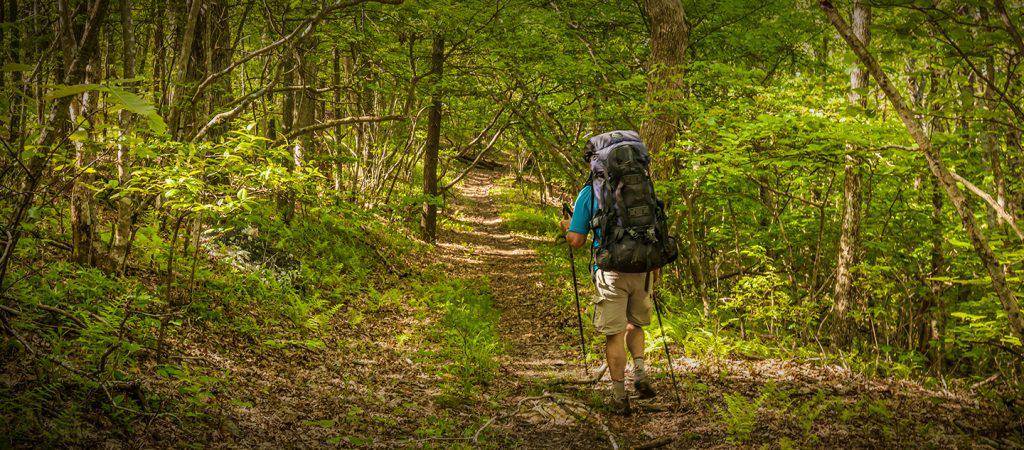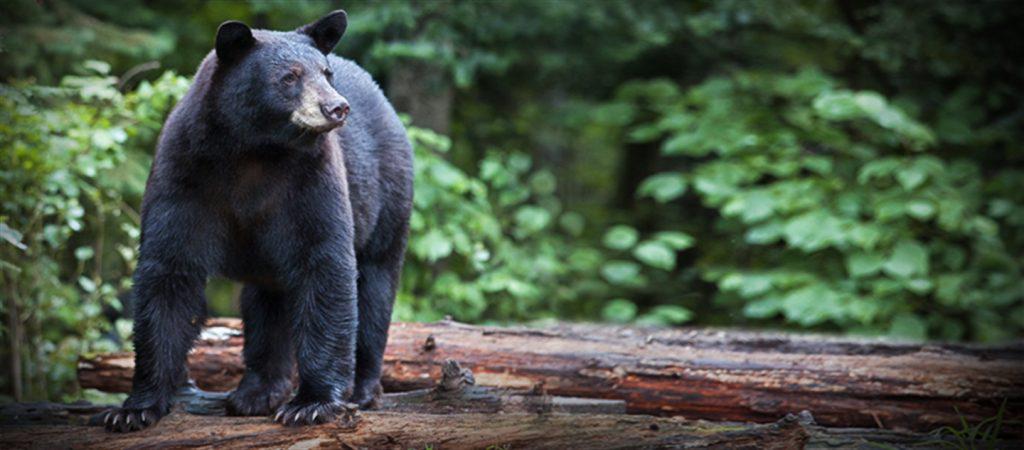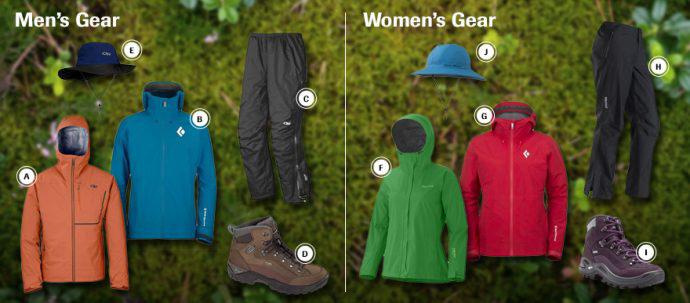 Every year, roughly 2,000 people attempt to thru-hike the entire 2,180 miles of the famous Appalachian Trail. Only one in four succeeds. Stretching from Georgia to Maine, the Appalachian Trail (A.T.) winds through snowy mountains and extensive farmland, attracting visitors from across the world to test their mettle. More than just a physical challenge, A.T. veterans regularly preach that the trail is a test of mental endurance. When you’re fighting off hordes of bugs in an old shelter or nursing a swollen ankle, you will undoubtedly question why you thought it was a good idea to attempt the hike in the first place. But the camaraderie, self-discovery, and beautiful landscapes make it worth every step. Are you ready to begin your journey?
Every year, roughly 2,000 people attempt to thru-hike the entire 2,180 miles of the famous Appalachian Trail. Only one in four succeeds. Stretching from Georgia to Maine, the Appalachian Trail (A.T.) winds through snowy mountains and extensive farmland, attracting visitors from across the world to test their mettle. More than just a physical challenge, A.T. veterans regularly preach that the trail is a test of mental endurance. When you’re fighting off hordes of bugs in an old shelter or nursing a swollen ankle, you will undoubtedly question why you thought it was a good idea to attempt the hike in the first place. But the camaraderie, self-discovery, and beautiful landscapes make it worth every step. Are you ready to begin your journey?
Mapping your route
 The Appalachian Trail is well defined from ages of use and good maintenance. Most hikers start at the south end of the trail in Georgia and head north, usually in late March or early April. Of course, while you will likely get to avoid most of the snow for the duration of the trip, it’s also the busiest time to leave. Just make sure you don’t start your hike on April 1st, which often means leaving alongside 100 other hikers on the same day. March 1st, 15th, and 17th are also busy days, as is the first day of spring. Instead, aim to start on a weekday or a day other than the 1st or 15th of March or April. There will still be plenty of people around to keep things lively, but you’ll have some elbow room. Instead of starting at the southern tip, some hikers choose to start up in Maine and head down. If you’re looking for a real challenge with far fewer crowds, this could be a great option. Just make sure you’re at the top of your game. The first task on the north end is to scale the mountain Katahdin, the highest mountain in Maine and most difficult part of the trail. If you haven’t built up your trail legs before you arrive, you could be in for some miserable days, a delayed schedule, and possibly an injury. An experienced hiker might like to start things off with a bang, but if you’re newer to long-distance backpacking, your best bet is to start back down south. Now, if you want a quieter hike without starting at Katahdin, you can avoid the crowds by starting in the middle or only travelling pieces of the trail. “Section hiking” lets you set your own pace and see different parts of the trail at the best times. For those who want to hike only half of the trail, a natural starting place is Harpers Ferry, West Virginia. Not only is it one of the most history-rich locations on the trail, Harpers Ferry is the only town on the route with 7-day train access. Spring also reaches the middle of the trail early, which means you’ll avoid the worst of the weather. Once you have your general route laid out, it’s only natural to wonder where you’ll sleep. Because the trail is so long, it’s difficult to plan out each rest stop ahead of time. Luckily, there are 250 shelters along the route maintained for hikers, and the trail also passes by towns where you can stop in for a night. Keep an eye on your phone’s GPS as you travel so you don’t miss an opportunity for a hot shower and fresh food stocks! One of the best maps to use for planning your trip is provided by the Appalachian Trail Conservancy. You can toggle through various filters to show noteworthy locations along the trail, such as parking and shelter locations. Find the map here.
The Appalachian Trail is well defined from ages of use and good maintenance. Most hikers start at the south end of the trail in Georgia and head north, usually in late March or early April. Of course, while you will likely get to avoid most of the snow for the duration of the trip, it’s also the busiest time to leave. Just make sure you don’t start your hike on April 1st, which often means leaving alongside 100 other hikers on the same day. March 1st, 15th, and 17th are also busy days, as is the first day of spring. Instead, aim to start on a weekday or a day other than the 1st or 15th of March or April. There will still be plenty of people around to keep things lively, but you’ll have some elbow room. Instead of starting at the southern tip, some hikers choose to start up in Maine and head down. If you’re looking for a real challenge with far fewer crowds, this could be a great option. Just make sure you’re at the top of your game. The first task on the north end is to scale the mountain Katahdin, the highest mountain in Maine and most difficult part of the trail. If you haven’t built up your trail legs before you arrive, you could be in for some miserable days, a delayed schedule, and possibly an injury. An experienced hiker might like to start things off with a bang, but if you’re newer to long-distance backpacking, your best bet is to start back down south. Now, if you want a quieter hike without starting at Katahdin, you can avoid the crowds by starting in the middle or only travelling pieces of the trail. “Section hiking” lets you set your own pace and see different parts of the trail at the best times. For those who want to hike only half of the trail, a natural starting place is Harpers Ferry, West Virginia. Not only is it one of the most history-rich locations on the trail, Harpers Ferry is the only town on the route with 7-day train access. Spring also reaches the middle of the trail early, which means you’ll avoid the worst of the weather. Once you have your general route laid out, it’s only natural to wonder where you’ll sleep. Because the trail is so long, it’s difficult to plan out each rest stop ahead of time. Luckily, there are 250 shelters along the route maintained for hikers, and the trail also passes by towns where you can stop in for a night. Keep an eye on your phone’s GPS as you travel so you don’t miss an opportunity for a hot shower and fresh food stocks! One of the best maps to use for planning your trip is provided by the Appalachian Trail Conservancy. You can toggle through various filters to show noteworthy locations along the trail, such as parking and shelter locations. Find the map here.
Safety on the trail
 Protect your body No doubt, 2,180 miles can do a number on your joints. Mitigating that risk begins with a light pack, especially if it’s your first time attempting a longer hike. Pack your essentials and then pare down, aiming for about 25-30 pounds. Many first-timers will buy a backpack for the trip, only to switch it out at the earliest opportunity for something smaller. To keep your skin healthy, don’t forget your sunscreen and a wide-brim hat. Most of the trail provides good shade, but the sunny stretches can be rough on your skin. If you do get burned, diaper cream can be a lifesaver. It’s also a must-have to prevent and soothe chafing. Look out for wildlife
Protect your body No doubt, 2,180 miles can do a number on your joints. Mitigating that risk begins with a light pack, especially if it’s your first time attempting a longer hike. Pack your essentials and then pare down, aiming for about 25-30 pounds. Many first-timers will buy a backpack for the trip, only to switch it out at the earliest opportunity for something smaller. To keep your skin healthy, don’t forget your sunscreen and a wide-brim hat. Most of the trail provides good shade, but the sunny stretches can be rough on your skin. If you do get burned, diaper cream can be a lifesaver. It’s also a must-have to prevent and soothe chafing. Look out for wildlife  Early risers are the ones who will get to see moose, deer, and even bears in those silent mornings. Although the trail passes through gorgeous, highly variable terrain, animals pose little threat to hikers. The shy black bears tend to stay away from groups (unless there’s food around), and most of the snakes you’ll encounter are harmless. However, you’re going to want to watch out for ticks. Some ticks carry Lyme disease, a serious infection that has the potential to affect joints, the heart, and the nervous system if left untreated. Wear light clothing that will allow you to see even the tiniest ticks, and do a daily check. Any ticks that make it to your skin should be removed with tweezers. Pay attention to other hikers The trail is known for its friendly community, but it’s not insulated from crime. Keep your wits about you when interacting with other hikers and don’t tell strangers your plans. If someone makes you feel uneasy, quickly put distance between him or her and yourself. If you are travelling solo or in a small group, try to find another group that you can tag along with for a while. Dress for the weather The Appalachian Trail crosses 14 states, which means you will face a satisfying variety of weather patterns. Your clothes must be able to transition. Avoid cotton, which will hold water against your body. Instead, synthetics and wool are the way to go, even for socks and undergarments. You’ll also want some solid rain pants for those chill, misty mornings.
Early risers are the ones who will get to see moose, deer, and even bears in those silent mornings. Although the trail passes through gorgeous, highly variable terrain, animals pose little threat to hikers. The shy black bears tend to stay away from groups (unless there’s food around), and most of the snakes you’ll encounter are harmless. However, you’re going to want to watch out for ticks. Some ticks carry Lyme disease, a serious infection that has the potential to affect joints, the heart, and the nervous system if left untreated. Wear light clothing that will allow you to see even the tiniest ticks, and do a daily check. Any ticks that make it to your skin should be removed with tweezers. Pay attention to other hikers The trail is known for its friendly community, but it’s not insulated from crime. Keep your wits about you when interacting with other hikers and don’t tell strangers your plans. If someone makes you feel uneasy, quickly put distance between him or her and yourself. If you are travelling solo or in a small group, try to find another group that you can tag along with for a while. Dress for the weather The Appalachian Trail crosses 14 states, which means you will face a satisfying variety of weather patterns. Your clothes must be able to transition. Avoid cotton, which will hold water against your body. Instead, synthetics and wool are the way to go, even for socks and undergarments. You’ll also want some solid rain pants for those chill, misty mornings. 
Men
A. Outdoor Research Axiom Jacket B. Black Diamond Liquid Point Shell Jacket C. Outdoor Research Foray Pant D. Lowa Renegade Mid GTX® Boot E. Outdoor Research Seattle Sombrero
Women
F. Marmot Minimalist Jacket G. Black Diamond Liquid Point Shell Jacket H. Marmot Minimalist Pant I. Lowa Renegade GTX® Boot J. Outdoor Research Raindance Sombrero While on the trail, you can check AT Weather to see the weather at upcoming locations. Many hikers also mail a “bounce box” from town to town as they travel that holds their seasonal clothing and keeps their packs light.
Leave no trace
Finally, always be conscious of the environmental impact you have on the trail. Whatever goods you bring onto the trail should be brought back to town, and any waste should be buried far from the walkway. The Appalachian Trail is an unforgettable experience, but only because its hikers and volunteers are committed to keeping it beautiful. Happy trails.
Further Reading
The Trail crosses many state lines, and the rules for camping, hunting, and campfires will be different in each area. Here are some resources to get you started: Appalachian Trail Data Book 2015: The top selling A.T. guide. Appalachian Trail Conservancy: The conservancy is a nonprofit that maintains the trail, and their website offers lots of first-hand information about the trail and what to expect. Appalachian Trail ‘Thru-Hiker’s’ Companion 2015: A guide that includes town maps, water sources, shelter locations, and more. If you’re doing sections of the hike at a time, it’s a great way to keep track of what you’ve covered.





